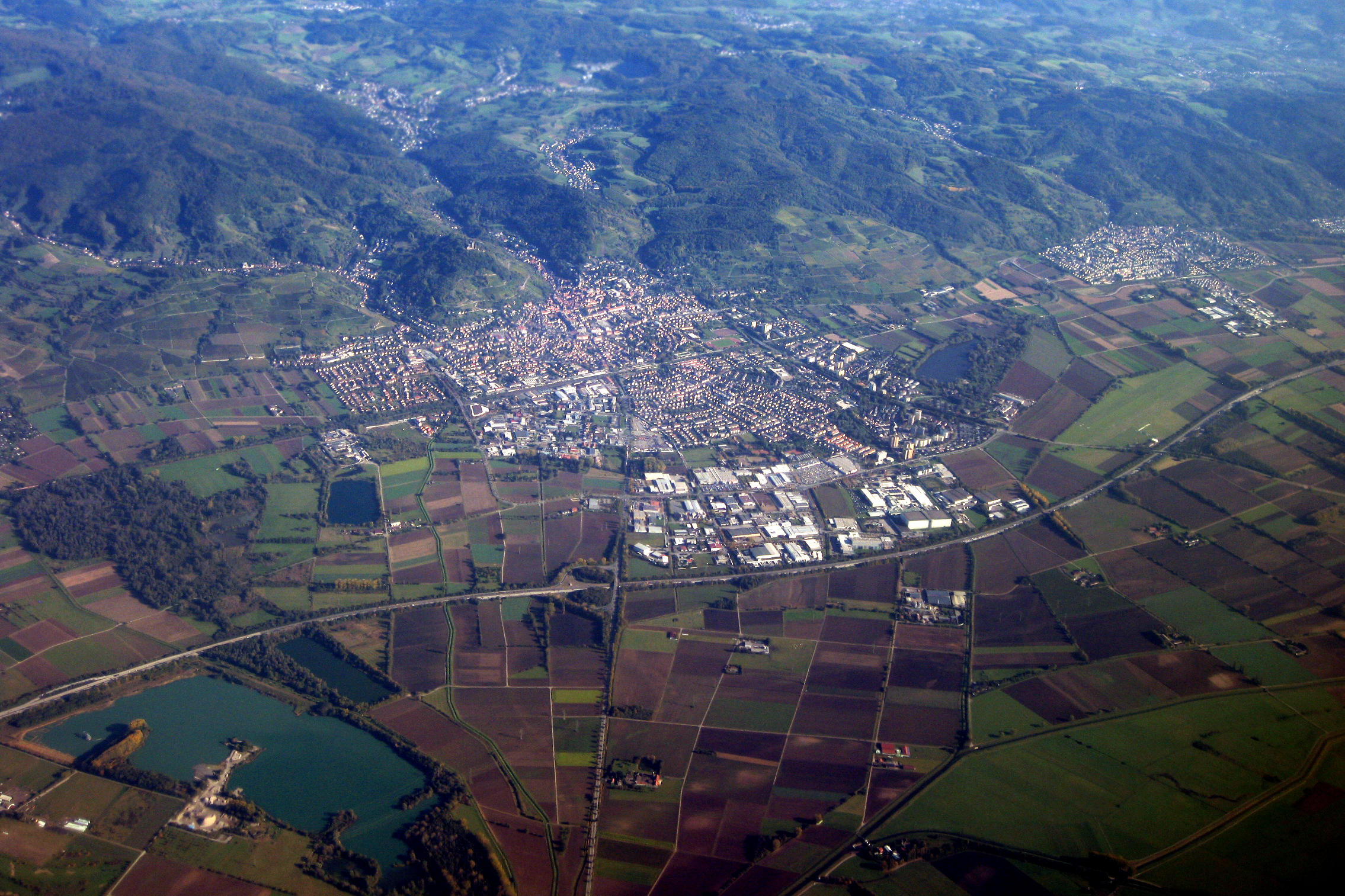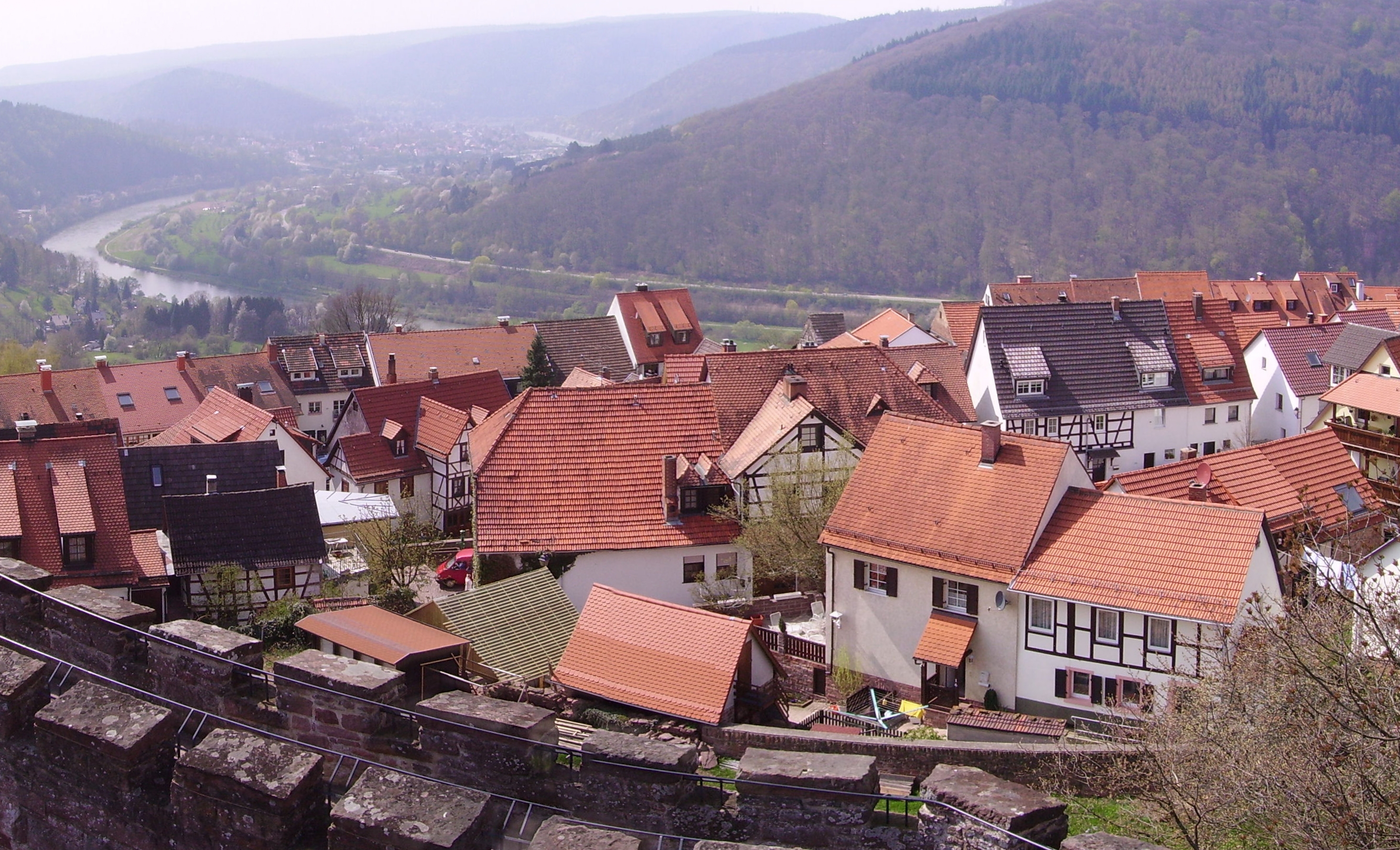|
Bergstraße (route)
The Bergstraße (, ) is an ancient trade route in the south-west of Germany, running north‒south from Darmstadt via Heidelberg to Wiesloch. The route and the area around it is a mountainous " theme route" running north–south along the western edge of the Odenwald forest in southern Hesse and northern Baden-Württemberg. The route passes through the Bergstraße administrative district, and independent viticultural regions of Hessische Bergstraße and Badische Bergstraße. Between the cities of Heidelberg and Weinheim the Upper Rhine Railway Company (OEG) tram route runs alongside. Route The route goes almost straight from north to south at the spot where the Rhine lowlands meet the western edge of the Odenwald. The name comes from the road's route along the foot of the mountains, the Rhine lowlands once being too damp to build a road there. The route mostly follows the modern B3 road. It begins in Darmstadt and, after passing through Eberstadt, splits into the "Old Be ... [...More Info...] [...Related Items...] OR: [Wikipedia] [Google] [Baidu] |
Darmstadt-Eberstadt
Eberstadt is the southernmost borough of Darmstadt in Hessen, Germany with a population of 23,728 (). Geography In the north Eberstadt borders the boroughs of Bessungen and Darmstadt-West, in the east and south the municipalities of Mühltal and Seeheim-Jugenheim and in the west to the town of Pfungstadt. Eberstadt is a part of the Bergstraße. Between Eberstadt and Zwingenberg it splits into the "Old" and "New" Bergstraße ( Bundesstraße 3). Statistical districts There are 5 statistical districts subdividing Eberstadt. Structure Eberstadt is spread mainly along Heidelberger Landstraße, which is also the route of the tram line to central Darmstadt. The historical village centre (Alt-Eberstadt) is at the intersection between Heidelberger Landstraße, running north-south, the eastbound Mühltalstraße and the westbound Pfungstädter Straße. This formerly marked the crossing point of Bundesstraße 3 and Bundestraße 426, but both these interregional roads now have bypas ... [...More Info...] [...Related Items...] OR: [Wikipedia] [Google] [Baidu] |
Heppenheim
Heppenheim (Bergstraße) () is the seat of Bergstraße district in Hesse, Germany, lying on the Bergstraße on the edge of the Odenwald. It is best known for being the birthplace of Sebastian Vettel, a four-time Formula One World Champion and the place of founding of the Free Democratic Party (Germany). Geography Location The town is set on the vineyards below the mediaeval Starkenburg (castle). Defining for the townscape, besides the castle, is ''St. Peter'', the “Cathedral of the Bergstraße” as the big Catholic church is known locally; it was consecrated on 1 August 1904, and is not a bishop's seat. Heppenheim lies centrally on ''Bundesstraßen'' 3 and 460, and Autobahn A 5/ A 67, almost halfway between Heidelberg and Darmstadt, in southern Hesse on the boundary with Baden-Württemberg, and is Hesse's southernmost district seat. The town's official designation is “Heppenheim an der Bergstraße”. In the local Hessian German dialect, the town is al ... [...More Info...] [...Related Items...] OR: [Wikipedia] [Google] [Baidu] |
States Of Germany
The Federal Republic of Germany is a federation and consists of sixteen partly sovereign ''states''. Of the sixteen states, thirteen are so-called area-states ('Flächenländer'); in these, below the level of the state government, there is a division into local authorities (counties and county-level cities) that have their own administration. Two states, Berlin and Hamburg, are city-states, in which there is no separation between state government and local administration. The state of Bremen (state), Bremen is a special case: the state consists of the cities of Bremen (city), Bremen, for which the state government also serves as the municipal administration, and Bremerhaven, which has its own local administration separate from the state government. It is therefore a mixture of a city-state and an area-state. Three states, Bavaria, Saxony, and Thuringia, use the appellation ("free state"); this title is merely stylistic and carries no legal or political significance (similar t ... [...More Info...] [...Related Items...] OR: [Wikipedia] [Google] [Baidu] |
Baden
Baden (; ) is a historical territory in southern Germany. In earlier times it was considered to be on both sides of the Upper Rhine, but since the Napoleonic Wars, it has been considered only East of the Rhine. History The margraves of Baden originated from the House of Zähringen. Baden is named after the margraves' residence, Hohenbaden Castle in Baden-Baden. Hermann II of Baden first claimed the title of Margrave of Baden in 1112. A united Margraviate of Baden existed from this time until 1535, when it was split into the two Margraviates of Baden-Durlach and Baden-Baden. Following a devastating fire in Baden-Baden in 1689, the capital was moved to Rastatt. The two parts were reunited in 1771 under Margrave Charles Frederick. The restored Margraviate with its capital Karlsruhe was elevated to the status of electorate in 1803. In 1806, the Electorate of Baden, receiving territorial additions, became the Grand Duchy of Baden. The Grand Duchy of Baden was a state ... [...More Info...] [...Related Items...] OR: [Wikipedia] [Google] [Baidu] |
Rhein-Neckar-Kreis
The Rhein-Neckar-Kreis is a district in the northwest of Baden-Württemberg, Germany. The administrative headquarters are based in the city Heidelberg, which is a district-free city. As of 2019, the district is the most populous in Baden-Württemberg. History The district was created in 1973 by merging the previous districts of Heidelberg, Mannheim and Sinsheim. Geography The district is named after the two main rivers which flow through the district, the Rhine and Neckar. The highest elevation is 580 m near the 584 m tall peak of the Odenwald mountain Stiefelhöhe, located near Heiligkreuzsteinach. The lowest elevation with 92 m is in Ilvesheim, located in the Neckar valley. Sights Government The district is governed by a district assembly (''Kreistag'') and a district executive ('' Landrat''). The eligible voters of the district elect the Kreistag every 5 years. This body in turn elects the Landrat every 8 years. The Landrat is the legal representative of the district as ... [...More Info...] [...Related Items...] OR: [Wikipedia] [Google] [Baidu] |
Kreis Bergstraße
Kreis is the German word for circle. Kreis may also refer to: Places * , or Circle (administrative division), various subdivisions roughly equivalent to counties, districts or municipalities ** Districts of Germany (including and ) ** Former districts of Prussia, also known as ** ''Kreise'' of the former Electorate of Saxony ** ''Kreis'' (Habsburg monarchy), a former type of subdivision of the Habsburg monarchy and Austrian Empire *, or Imperial Circles, ceremonial associations of several regional monarchies () and/or imperial cities () in the Holy Roman Empire People * Harold Kreis (born 1959), Canadian-German ice hockey coach * Jason Kreis (born 1972), American soccer player * Melanie Kreis (born 1971), German businesswoman * Wilhelm Kreis (1873–1955), German architect Music and culture *''Der Kreis'', a Swiss gay magazine * ''Kreise'' (album), a 2017 album by Johannes Oerding See also * Krai, an administrative division in Russia * Kraj, an administrative divisi ... [...More Info...] [...Related Items...] OR: [Wikipedia] [Google] [Baidu] |
Landkreis Darmstadt-Dieburg
Darmstadt-Dieburg is a Kreis (district) in the south of Hesse, Germany. Neighboring districts are Offenbach, Aschaffenburg, Miltenberg, Odenwaldkreis, Bergstraße, Groß-Gerau, and the district-free city of Darmstadt, which it surrounds. History The district was created in 1975 by merging the previous districts of Darmstadt and Dieburg. In 1963 the district was twinned with the district of North East Derbyshire, England, in 1990 with the district Zwickauer Land in Saxony, Germany, and in 1995 with the Mladá Boleslav region in the Czech Republic. Geography The district is located in the Odenwald mountains. Most famous in the district is the Messel Pit, where many fossils in the oil shale of a Tertiary lake were found. The site is listed in the UNESCO world heritage list since 1995. Coat of arms The coat of arms show a lion in the top part, taken from the coat of arms of the counts of Katzenelnbogen. The lion holds a Wheel of Mainz, the symbol of state of Mainz Ma ... [...More Info...] [...Related Items...] OR: [Wikipedia] [Google] [Baidu] |
List Of German Urban Districts
A list is a set of discrete items of information collected and set forth in some format for utility, entertainment, or other purposes. A list may be memorialized in any number of ways, including existing only in the mind of the list-maker, but lists are frequently written down on paper, or maintained electronically. Lists are "most frequently a tool", and "one does not ''read'' but only ''uses'' a list: one looks up the relevant information in it, but usually does not need to deal with it as a whole".Lucie Doležalová,The Potential and Limitations of Studying Lists, in Lucie Doležalová, ed., ''The Charm of a List: From the Sumerians to Computerised Data Processing'' (2009). Purpose It has been observed that, with a few exceptions, "the scholarship on lists remains fragmented". David Wallechinsky, a co-author of '' The Book of Lists'', described the attraction of lists as being "because we live in an era of overstimulation, especially in terms of information, and lists help us ... [...More Info...] [...Related Items...] OR: [Wikipedia] [Google] [Baidu] |
Neckar
The Neckar () is a river in Germany, mainly flowing through the southwestern States of Germany, state of Baden-Württemberg, with a short section through Hesse. The Neckar is a major right tributary of the Rhine. Rising in the Schwarzwald-Baar-Kreis near Villingen-Schwenningen, Schwenningen in the ''Schwenninger Moos'' conservation area at a height of above sea level, it passes through Rottweil, Rottenburg am Neckar, Kilchberg (Tübingen), Kilchberg, Tübingen, Wernau, Nürtingen, Plochingen, Esslingen am Neckar, Esslingen, Stuttgart, Ludwigsburg, Marbach am Neckar, Marbach, Heilbronn and Heidelberg, before discharging on average of water into the Rhine at Mannheim, at above sea level, making the Neckar its 4th largest tributary, and the 10th largest river in Germany. Since 1968, the Neckar has been navigable for cargo ships via 27 locks for about upstream from Mannheim to the river port of Plochingen, at the confluence with the Fils (river), Fils. From Plochingen to Stuttg ... [...More Info...] [...Related Items...] OR: [Wikipedia] [Google] [Baidu] |




